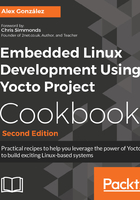
上QQ阅读APP看书,第一时间看更新
How it works...
When you pass a target recipe to BitBake, it first parses the following configuration files in order:
- conf/bblayers.conf: This file is parsed to find all the configured layers
- conf/layer.conf: This file is parsed on each configured layer
- meta/conf/bitbake.conf: This file is parsed for its own configuration
- conf/local.conf: This file is used for any other configuration the user may have for the current build
- conf/machine/<machine>.conf: This file is the machine configuration; in our case, this is qemuarm.conf
- conf/distro/<distro>.conf: This file is the distribution policy; by default, this is the poky.conf file
There are also some other distribution variants included with Poky:
-
- poky-bleeding: Extension to the Poky default distribution that includes the most up-to-date versions of packages
- poky-lsb: LSB compliance extension to Poky
- poky-tiny: Oriented to create headless systems with the smallest Linux kernel and BusyBox read-only or RAM-based root filesystems, using the musl C library
And then, BitBake parses the target recipe that has been provided and its dependencies. The outcome is a set of interdependent tasks that BitBake will then execute in order.
A depiction of the BitBake build process is shown in the following diagram:

BitBake build process